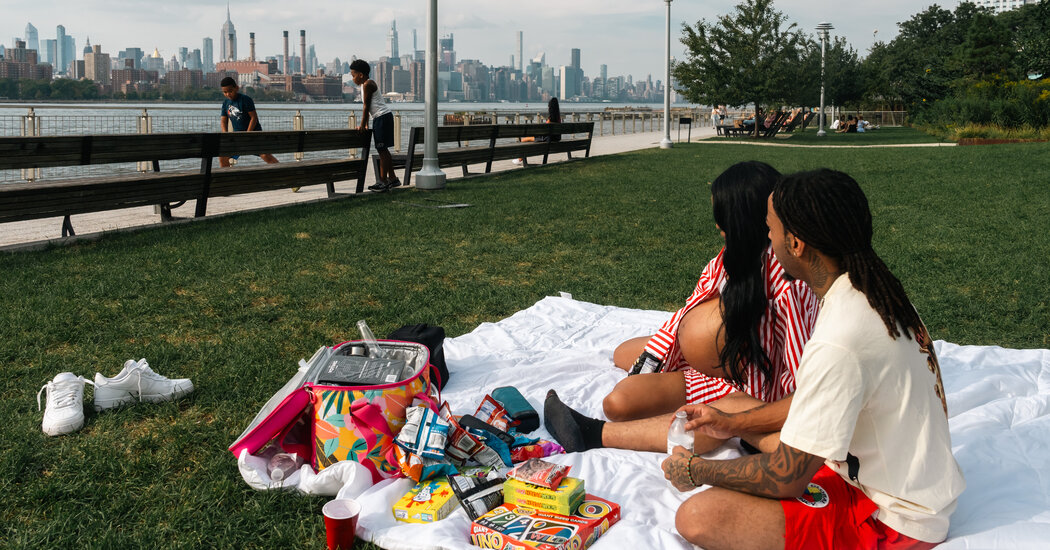Typically, September in New York City starts to show hints of fall, with average temperatures in the 70s, as children return to school. But this week, the back-to-school season has felt more like a last gasp for summer, with a three-day heat wave sending temperatures 20 degrees higher than usual.
“This does not feel like back-to-school weather,” said Vanessa West, who had taken two of her children, Madison, 8, and Deon, 4, to a public pool in Harlem on the last day before public schools open on Thursday. “Not at all.”
She said she was concerned about regular access to air-conditioning at her daughter’s school, the lack of which could result in dehydration and heat exhaustion. “I think this is global warming at its finest,” Ms. West said, adding that she would be sending her daughter to school with a mini water cooler to keep at her desk.
Outside the pool, Bianca Cruz, 29, and her two sons, Jeysen Randolph, 11, and David Claros, 6, bought vanilla ice cream cones with rainbow sprinkles from an ice cream truck. Dressed in Crocs sandals, swim trunks and tank tops, the boys looked like poster children for July in New York. “It’s not usually this hot in September,” Ms. Cruz said. “But the weather is changing.”
A spokeswoman for the New York City Department of Education said on Wednesday that it had been communicating with New York City Emergency Management and the National Weather Service to prepare for the reopening of the country’s largest school district amid a heat advisory.
The department is advising schools to limit outdoor activities on the first day back between 10 a.m. and 6 p.m. and to move anything strenuous to indoor air-conditioned settings.
Outside of the city, and across the Mid-Atlantic and Northeast, many schools already in session were reducing their hours as they grappled with unusually high temperatures that their buildings are not usually prepared for.
In Connecticut, where Gov. Ned Lamont enacted the state’s extreme heat weather protocol this week, schools released students early on Wednesday, canceling after-school activities or moving sports team practices to later in the day.
At one school in West Haven, Conn., yellow buses pulled up at midday, hours before the normal dismissal time. Children boarded directly from the building; no standing outside today.
“Phew,” one little girl said, exaggeratedly, wiping her brow as she hurried to the bus.
In Branford, Conn., none of the three elementary schools have central air conditioning, said Christopher Tranberg, the superintendent. But the middle and high schools do, so educators and officials brought over fans to help younger students stay cool. “We’re dealing with extreme temperatures now more than we ever have before,” Dr. Tranberg said.
On Tuesday, some classrooms at one elementary school in Branford recorded temperatures between 82 and 86 degrees, Dr. Tranberg said. Only a few classrooms there have window units, so teachers kept the lights turned off all day. Dr. Tranberg said that the heat was especially challenging early in the semester. “One of the important things about elementary education, especially, is establishing those routines at the beginning of the year,” he said. “And this is a major disruption.”
A recent study published in the journal Nature Human Behavior found that students’ rate of learning decreases as the number of hot school days increase, and these climate differences can worsen educational achievements on socioeconomic lines.
In New Jersey, the Bridgewater-Raritan Regional School District switched to four-hour days. In Philadelphia, schools with no or inadequate cooling systems introduced three-hour early dismissals. In Ohio, many schools simply closed.
But extreme heat is here to stay, so schools and other social services should prepare, experts said. “Climate change is ‘juicing’ the odds for severe heat waves pretty much everywhere,” said Gavin A. Schmidt, the director of the NASA Goddard Institute for Space Studies.
Dr. Schmidt said attempts at mitigating the heat can help, like planting more trees and painting roofs white, “but the biggest issue is that we are still emitting greenhouse gases,” he said, “and until that stops, temperatures will continue to climb and heat waves will continue to get worse.”
And because of climate change, back-to-school seasons with temperatures in the 90s will not be uncommon, said Rohit T. Aggarwala, New York City’s chief climate officer.
“What we’re going to see — we’ve already seen it here and around the world in the last 10 years, is basically whatever the profile is, it just gets elevated,” he said. “So just like July and August are hotter, September is going to be hotter.”
Colbi Edmonds, Claire Fahy, Amelia Nierenberg and Erin Nolan contributed reporting.











